This is a Minolta Maxxum 800si, a 35mm single lens reflex camera produced by Minolta starting in 1997. The 800si was the flagship model in Minolta’s fourth generation of autofocus SLRs after it’s predecessor, the 9xi was discontinued. When the Maxxum 800si was sold in Europe and Japan, it was known there as the Dynax 800si and the α-807si, respectively. The 800si would be replaced by the Maxxum/Dynax 7 in 1999, but for a brief moment in time, was Minolta’s most advanced SLR. It’s most notable feature is the huge pop-up flash which had a moving reflector that covered lenses from 24mm to 80mm. It was also more powerful than other pop-up flashes and supported wireless sync with other Minolta flashes, bridging the gap between a built in flash and external speed light. Despite including a large number of additional features from the step down 700si, the 800si wasn’t much larger, and weighed about the same, making for a compact, semi professional flagship SLR.
Film Type: 135 (35mm)
Lens: 50mm f/1.7 Minolta Maxxum AF coated 6-elements in 4-groups + others
Lens Mount: Minolta Alpha Bayonet
Focus: 1.5 feet to Infinity (50mm), 1 foot to Infinity (28mm)
Viewfinder: Fixed SLR Pentaprism
Shutter: Electronic Vertically Traveling Focal Plane
Speeds (auto): 30 – 1/8000 seconds, step less
Speeds (manual): B, 30 – 1/8000 seconds
Exposure Meter: 2x Silicon Photo Diode TTL meters with P, Ps, Pa, S, A, and M metering modes
Battery: 6v 2CR5 Lithium Battery
Flash Mount: Minolta Hot Shoe with Pop-Up in Body Flash, 1/200 X-sync
Weight: 842 grams (w/ battery and 50mm f/1.7 lens), 659 grams (w/ battery, no lens)
Manual: https://mikeeckman.com/media/Minolta800siManual.pdf
How these ratings work |
The Minolta Maxxum 800si was the top of the line in Minolta’s fourth generation of auto focus film SLRs when it was first released and it is absolutely loaded with features, including a massively large and powerful flash, an exposure data storage system, and a very flexible auto exposure system. This camera originally did not sell well, likely because it was too much for the market, but at the prices they can be found today, makes for an excellent fully automatic SLR with the features and ergonomics of a modern camera. | ||||||
| Images | Handling | Features | Viewfinder | Feel & Beauty | History | Age | |
| 2 | 2 | 2 | 2 | 2 | 1 | 0% | |
| Bonus | +1 for the complete package, one of the most natural SLRs I’ve ever used, excellent knobs | ||||||
| Final Score | 12.0 | ||||||
Prologue
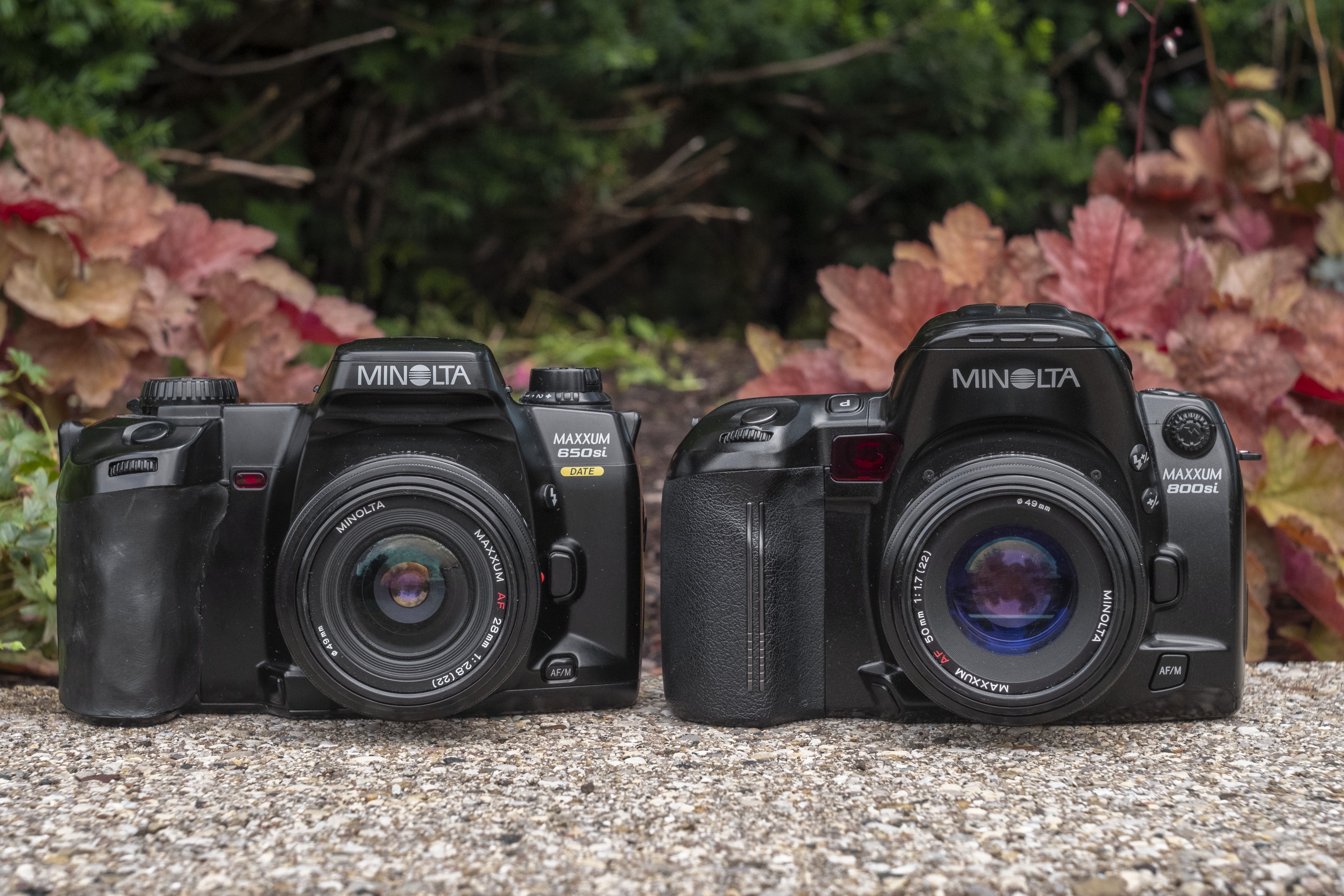
This review will be very short as it is more of a supplement to the previous review of the Minolta Maxxum 650si Date that I published earlier this week. The reason for this review immediately after that one as I found the 650si to have the perfect balance of everything I needed in an advanced, yet fully automatic 35mm SLR.
Although I love the 650si and consider it to be one of my all time favorites, I couldn’t help but wonder if the step up (actually two steps) Maxxum 800si would be even better, so this review will be a look at what’s different between the two in an effort to see if Minolta was able to improve on what for me is a fantastic camera.
History
In every lineup of cameras, there are the entry level “consumer” models, step up advanced consumer (sometimes called “prosumer) models, then there’s enthusiast cameras and finally flagship models. What constitutes one model’s tier over another varies by manufacturer and even within the lineup of currently available models, sometimes is inconsistent or overlaps with other models.
 Ever since releasing their first SLR, the Minolta SR-2 in 1958, Minolta aimed to have a wide range of SLRs, with models in almost every segment except. Minolta rarely went head to head with Nippon Kogaku’s Nikon F-series, which considered of the original F and it’s replacements, the F2 through F6. Where Nippon Kogaku prioritized extreme build quality and interchangeable parts at the cost of innovative new technologies, Minolta embraced new ideas. Features like electronic shutters, automatic focus, extremely high top speeds, and other unnecessary but cool features were common in Minolta’s flagship models.
Ever since releasing their first SLR, the Minolta SR-2 in 1958, Minolta aimed to have a wide range of SLRs, with models in almost every segment except. Minolta rarely went head to head with Nippon Kogaku’s Nikon F-series, which considered of the original F and it’s replacements, the F2 through F6. Where Nippon Kogaku prioritized extreme build quality and interchangeable parts at the cost of innovative new technologies, Minolta embraced new ideas. Features like electronic shutters, automatic focus, extremely high top speeds, and other unnecessary but cool features were common in Minolta’s flagship models.
With the Maxxum 9000’s release in 1985, it was billed as the world’s first professional auto focus SLR. It had a vertically traveling shutter capable with a top 1/4000 shutter speed. It supported a variety of automatic exposure models from manual to fully programmed modes. When metering, it supported spot, multi-spot, average, center weighted, highlight, and shadow modes.
It’s replacement, the Maxxum 9xi from 1992 upped the ante further with a shutter capable of a blistering fast (even by today’s standards) top shutter speed of 1/12,000, a full information viewfinder with a clever feature that would project some information such as exposure compensation within the viewable prism, and a futuristic minimalist design hiding many of the camera’s functions using buttons.
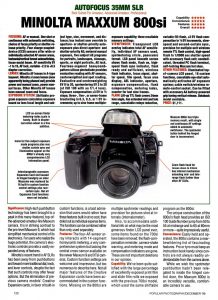
When the Maxxum 9xi was discontinued in 1996, there was a one year gap before it’s true replacement, the Maxxum 9 would be available, so for one year, Minolta’s advanced SLR was a new model released in 1997 called the Maxxum 800si.
Not quite “professional level”, the Maxxum 800si packed in a ton of technology making it a compelling option for the enthusiast who likes a long list of features.
The camera’s most striking feature is the large pop up flash atop the pentaprism. Most professional level SLRs like the 9xi and the Nikon F-series do not come with a pop up flash, as it’s assumed the photography will use some kind of Speedlite. The 800si bridges that gap with a near-pro level camera with a pop up flash.
But the Maxxum 800si’s flash isn’t just any flash. This thing is huge. With a much larger strobe and reflector, plus the ability to focus the light for lenses with a field of view from 24mm to 80mm, the 800si’s flash was almost like having a Speedlight built into the camera.
The Maxxum 800si had a long list of features which as you might imagine, also included a rather high price tag. With an MSRP of $1111 (no joking) that when adjusted for inflation, compares to just under $1900 the camera was well in the middle of a mid to upper tier camera.

Of course, MSRP and “street price” aren’t the same thing, so I wanted to get a better idea of what someone might actually pay for the camera and I found the ad to the left from Abe’s of Main in August 1999 which shows the 800si with lens, flash, and some other accessories for a much more reasonable $679.99.
The Minolta 800si offered a lot of features for the money, but didn’t seem to sell well as the camera doesn’t appear to be made past the year 2000 and they’re quite difficult to find used today. The Wikipedia page for the Minolta A-mount system has a chart that suggests the 800si was produced until 2006, which I do not believe to be true as I found no evidence of it being offered new in any ads from contemporary magazines past 2000, not to mention an internet forum post from November 2003 suggests it has long since been discontinued, giving more support that the Wikipedia page is not correct.
The Maxxum 800si appears to be an enthusiast level camera with a feature set and a price that intimidated most customers, making it far too complex for the beginner or mid-level photographer, but not having that “flagship” level status that a pro would purchase. These types of cameras are interesting to me in that they represent a company’s attempt to force their way into a market that either didn’t exist, or wasn’t as receptive as they thought.
Today, cameras like the Maxxum 800si all appear to fall into a broad category of forgettable fully automatic 35mm SLRs. Without an enthusiast following like the Nikon F6 or Canon EOS 1v, very few of Minolta’s 1990s Maxxums get a lot of love from collectors, which is a shame as these cameras were the pinnacle of continued advancement of 35mm cameras throughout the 20th century. There is still a lot of demand for people to shoot film today, and if you want a camera that has a modern interface, an excellent set of features, and a wide selection of excellent lenses, the Maxxum 800si is definitely a camera you should consider.
My Thoughts
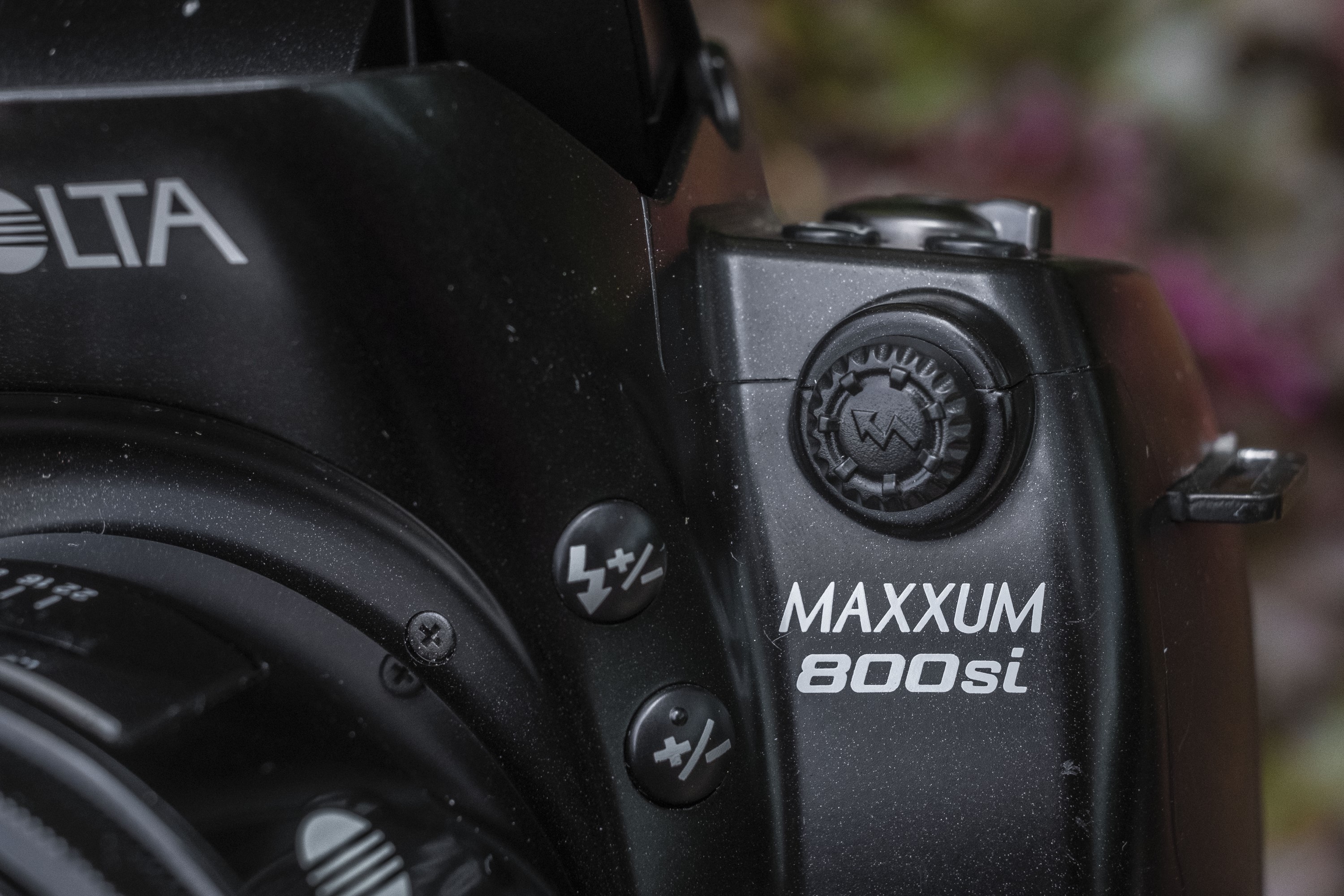
In the years since I bought my Minolta Maxxum 650si, it has become a frequent “vacation” camera for when I want to shoot film, but also want the assurance of a camera that all but guarantees I’ll get good shots from. As much as I like shooting obscure rangefinders like the Clarus MS-35 or folding Kodaks, those cameras require a level of thought and preparedness that makes capturing spontaneous candid shots difficult, not to mention, they can break at any moment.
Realizing that I was shooting my 650si more and more, I thought that it might be wise to have a backup, so I started looking for a backup body. There were certainly some out there, but I’m also cheap and wanted to wait for one at the right price to come along.
As these things often happen, in my search for a 650si, I stumbled upon an inexpensive Maxxum 800si that I couldn’t pass up. Realizing this camera was from the same generation and had many of the same features, I wanted to see how it would compare to my beloved 650si.
The ergonomics of the 800si are quite good. Compared to the 650si, the larger flash and top LCD give the camera a more imposing appearance when in reality, the differences between the two are very small. Excluding the flash on top of the pentaprism, which is definitely bigger, the width and depth of the two bodies are exactly the same, as is the size of the right hand grip. The height of the top plate is a little higher on the 800si, but side by side, the tall mode selector knob on the 650si peaks the overall top plate of the 800si.
Weight is similar too. With a body only weight (including battery) of 659 grams, the 800si is a mere 24 grams heavier than the 650si at 635 grams which is indistinguishable when holding both cameras at the same time.
The ergonomics are nearly the same as well as both shutter releases are in the same location and have the same comfortable contour for your right index finger. Both also have a very similar right thumb “bump” on the back door of the camera allowing for a secure one handed grip.

One tactile difference between the two is whatever material the 800si’s hand grip is covered in, does not appear to have the same age related problem of the 600/650si series in which the entire thing crumbles away. The 800si’s grip is made of a pebbled artificial leather that feels great in my hand and shows no signs of peeling or cracking. Although this is the only 800si I’ve ever handled, a quick eBay search of six other Minolta 800si bodies show no signs of deterioration, suggesting mine is not an anomaly. Also, there is no issue of stickiness anywhere else on the camera as is the case of some other prosumer cameras like the Minolta Dynax 7 or Nikon F100.
Both the 800si and 650si have a huge number of features, many of which I’d never use. I won’t go over all of the differences, but I’ll cover a few highlights.
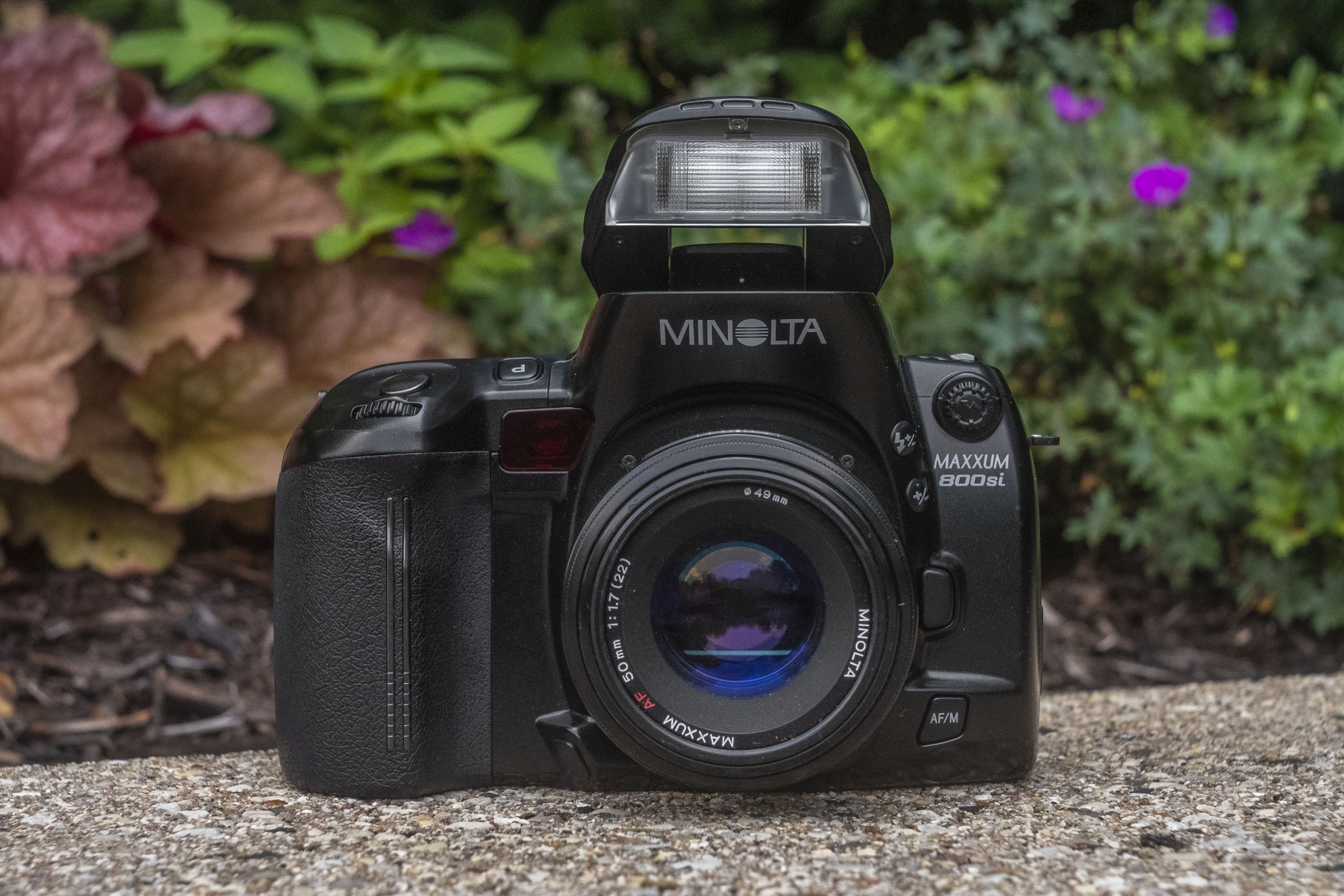
The most obvious is the flash. The Minolta Maxxum 800si has the largest pop up flash of any camera I’ve ever seen and probably the most powerful too. I do not take many flash photos, but an unscientific comparison of me turning out the lights in a dark room and triggering both the flash on the 800si and the 650si, and the 800si definitely lights up the room more. According to the short review linked to above from Popular Photography’s December 1999 issue, the 800si provides an impressively useful ISO 100 Guide number jump from 50 to 55 at midrange and to 65 at 80mm or more.
The spec sheet for the camera lists the flash as having an angle of coverage between 24mm and 80mm, a 3 second recycling time, and a reach of over 16 feet, which is very impressive for a pop up flash.
It supports wireless flash synchronization with standalone Minolta flashes, and when used with the Minolta 5400HS flash (sold separately), offers flash synchronization up to 1/8000 seconds.

Three other features about the 800si that I like are that it support’s Minolta’s Eye Start system which uses two sensors at the base of the eye piece that activates both the viewfinder LCD and the auto focus system when brought to your eye. Eye Start works with the two vertical metal stripes on the hand grip which when the camera is in your hand, activates the Eye Start system. If you set the camera down, the camera’s auto focus and exposure system will power off after 5 seconds unless you pick the camera back up. This feature would eventually become standard on film and digital SLRs made by almost every company in the years to come, so it’s inclusion here is a welcome convenience. I’m not suggesting that the lack of this feature on the 650si makes it hard to use, but is one little bonus to the 800si.
I also applaud the inclusion of a “Program Reset” button above the top plate LCD which resets most custom settings, returning them to their defaults. I’ll admit that there have been many instances over the years where I’ve fiddled with custom settings on a camera and forgotten how to change them back. With a single press of the Program Reset button, the camera is ready to go without you having to remember what settings you’ve changed. One minor nitpick though is the convenient location of this button could also result in accidental presses, disabling features you didn’t want to turn off, so it’s something you’d need to be careful of.
A third feature which I liked is what Minolta calls Creative Exposure Control when used with the Programmed Auto Exposure mode. With the camera set to “P” mode, the camera handles all exposure settings as you would expect any other camera with this mode. But if for whatever reason, you want to make quick adjustments to aperture or shutter speeds without having to fully change modes, with the shutter release half pressed, rotate either the rear or front mode selection dials to change aperture or shutter speeds respectively, and the camera will enter Pa or Ps modes, allowing you to override just those settings while keeping everything else the same.
The viewfinder is as big and bright as the one on the 650si with the same backlit green LCD display as the one found in the 650si. The viewable image is clear and bright corner to corner with no significant vignetting when using the 50mm f/1.7 AF lens.
One improvement over the 650si which is neat is that it uses projected LCD frame lines to indicate the auto focus mode. In averaging mode, large brackets cover the middle third of the viewfinder, but using the AF button on the back and the rear control dial. you can select through four different spot focus modes, which are indicated by a smaller rectangle in the position where the camera will focus. In the gallery above, the street scene is in averaging mode, and the sky is center spot.
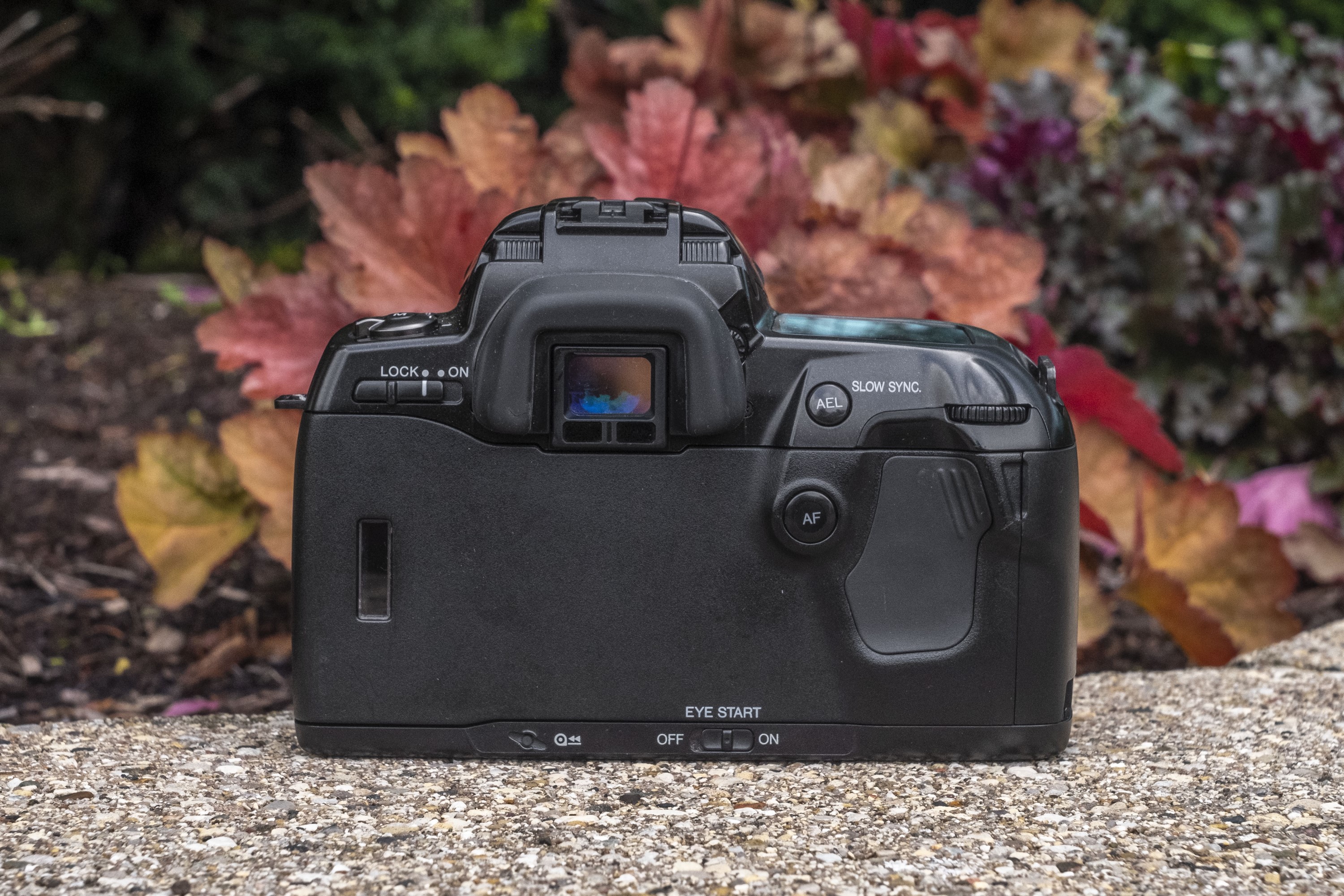
There’s a saying that sometimes less is more, and that sums up what I think is the camera’s biggest downfall, which is that perhaps it has too many features. Sometimes in the chase for the latest and greatest, the simplicity of an automatic camera gets lost in a endless sea of buttons and switches. The Minolta Maxxum 800si is not unlike many advanced digital cameras today in that you definitely need to read the manual to fully understand how it all works.
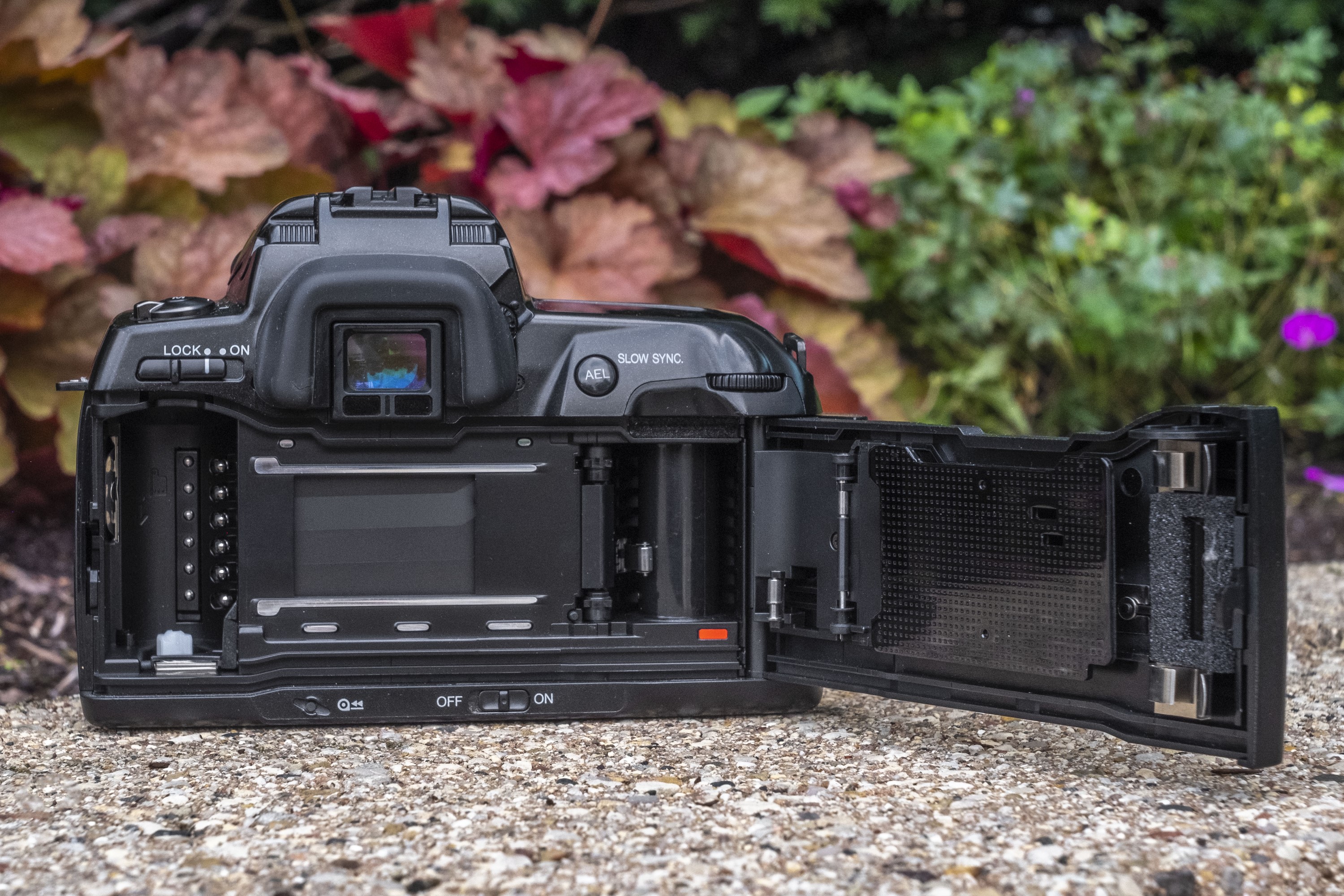
While I am a huge fan of customizing my gadgets to how I like it, without the manual, you’d have no idea that the 800si can be set to count exposures backwards, showing how many are left, rather than how many are taken. You would have no way of knowing that the grip sensor can be deactivated with the Eye Start feature which is useful if you are using the camera with an auxiliary hand grip, or while wearing gloves. Looking through the 800si’s manual, I see a lot of things that might be useful which not everyone needs.
But even features that you do need such as activating the red eye reduction flash or enabling the self-timer are hidden under a door on the camera’s side. I wouldn’t say they’re hard to use, but seem to be a little too far out of the way for the average person. Burying buttons like these behind a door goes a long way in cleaning up the body to give it a sleek appearance, but might also dissuade people from using them.
Finally, one last feature that neither falls into a “things I like” or “things I don’t like” category, is the Data Memory feature, in which the camera can remember things about each exposure made, for up to 9 rolls of film.
The data memory feature is like a primitive EXIF system recording aperture, shutter speed, lens focal length, exposure compensation, flash compensation, flash status (on/off), and bracketing (if used). Each exposure is recorded into the camera’s memory and is reviewed using the top plate LCD screen afterwards. As neat as this sounds, it’s not something I would ever do, so for those photographers who like to record exposure information for every image they take, this likely was an invaluable feature, as it would have eliminated pen and paper exposure ledgers.
My Results
I guess it’s time to conclude whether or not the Minolta Maxxum 800si actually improves enough for me to declare it my favorite modern film SLR.
My knee jerk reaction to the 800si when it arrived was that of disappointment as I didn’t get that immediate sense of infatuation as I did when I first handled the 650si. Soon thereafter, the rational side of me kicked in that I knew that just because the 800si was a higher end camera, does not automatically mean it would be better. I also knew that I would have to spend some time with the camera to familiarize myself with it’s features, controls, and various nuances.
Some of the additional features are actually quite useful. Eye Control is nice, and in the instances where I need the world’s most powerful pop-up flash, the 800si is the camera to have, plus, for as happy as I was with the home made Sugru grip I made for the 650si, not having to do it at all is definitely the better option.
When I first started working on this review, I said I wouldn’t need to shoot any film in it as the images would look indistinguishable from those from the 650si, which is a true statement. In fact, the 800si came to me body only, so I’m using the exact same lenses as I did on the 650si, so of course they’d look the same. If you want to see what the results from an autofocus Minolta SLR, here are images from the same gallery I used in the 650si review.
But of course, an opinion of any camera cannot be formed solely on images alone. How easy was it to get those images? What kinds of obstacles got in the way or what kinds of things made getting those images better?
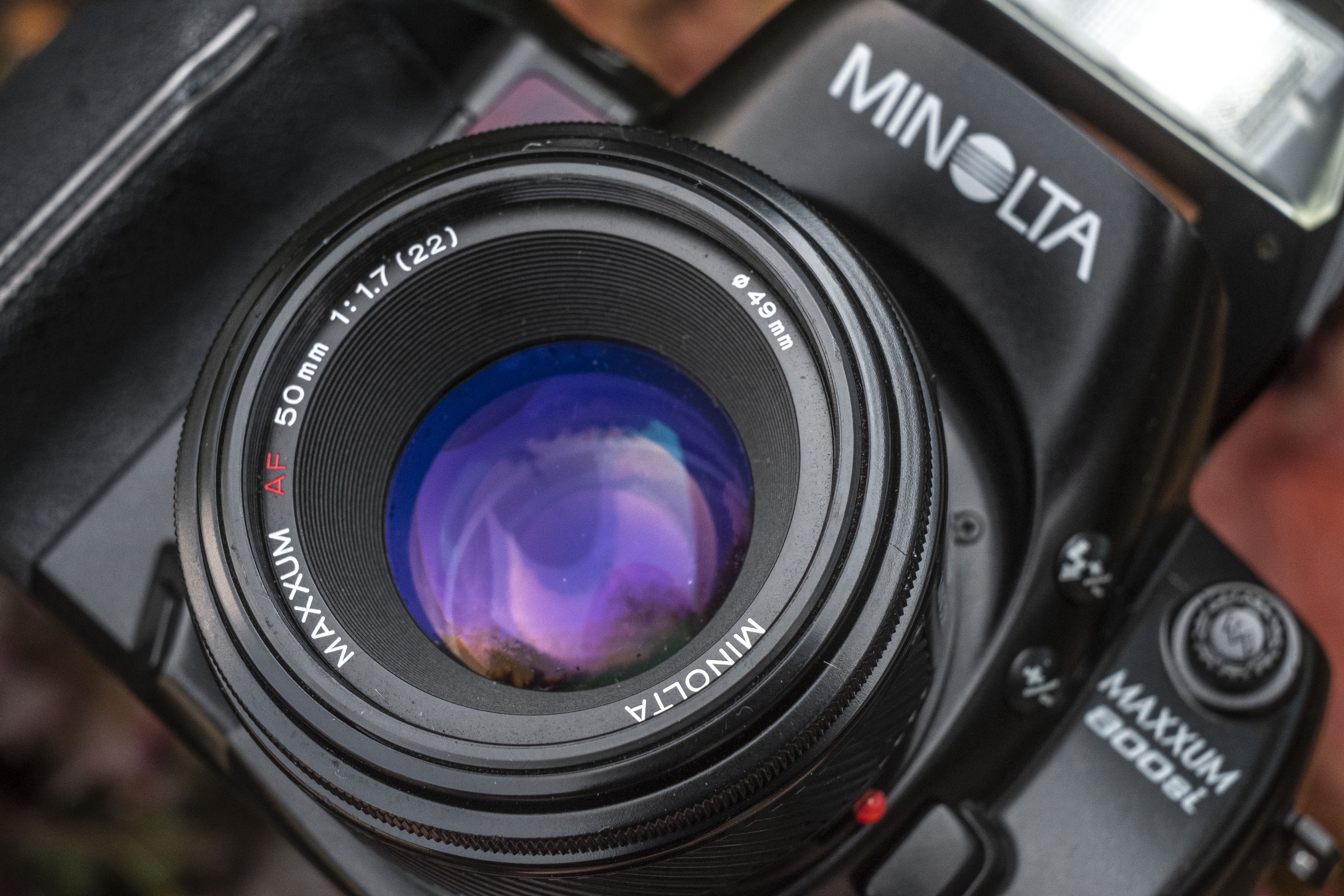
I can conclude that the ergonomics are close enough to the same to call this one a tie. Despite the bulbous appearance of the 800si’s flash, the camera feels and weighs the same in your hands, which is to say, excellent. I loved handling the 800si as much as the 650si.
Another area in which I am very sensitive to is the viewfinder, and both are excellent. The 650si and 800si both have very modern DSLR-like viewfinders that are bright and easy to use. Both use the same kind of exposure recommendations in Manual mode which I loved about the 650si, both have focus confirmation when manually focusing, and both have excellent displays that give you everything you’ll ever need.
I’m a sucker for the old school knobs of the 650si, but I found that once I wasn’t holding the 650si anymore, I didn’t miss them. The controls on the 800si are easy to use and work just as well, and if I’m being honest, I like the large LCD showing the status of the camera on the top plate. Initially, I wasn’t as much of a fan of the hidden controls under the secret door on the side, but after handling the camera and realizing I didn’t need them that often, I actually like the less cluttered look of the camera.
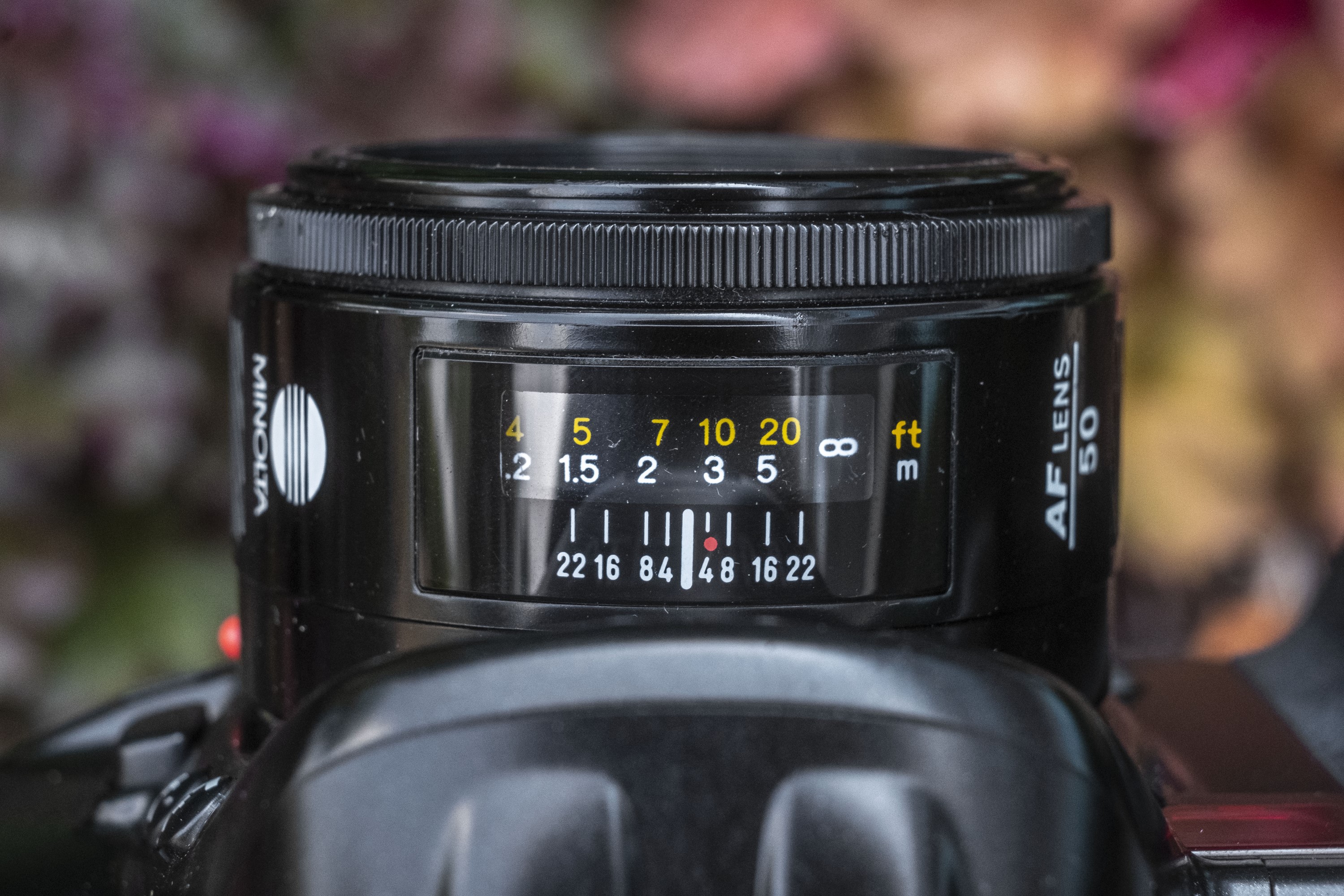
The 800si supports everything the 650si does, and more. I don’t think that Ps and Pa modes are going to make my images any better, nor does the Eye Start feature make shooting the camera any easier, but their inclusions are nice to have, which I think is a fair assessment of the entire camera.
Any negatives I might find about the camera are well into the realm of nitpicking, such as I couldn’t ever get used to the power switch being on the left side of the camera or that despite the usefulness of the “P” reset button, there was a couple of time I accidentally pressed it, losing my settings, but those to me are all issues that would disappear with repeated use.
Overall, the Minolta Maxxum 800si is one hell of a camera. Everything (except the knobs) I love about the 650si is still here but with a few extra features that if you want them, you can use, but won’t stop you from making great photos. For the film photographer in 2021, if you want an EXCELLENT fully automatic and modern 35mm SLR, I feel comfortable recommending both the 650si and the 800si.
Related Posts You Might Enjoy
External Links
http://camera-wiki.org/wiki/Minolta_Dynax_800_si
https://www.35mmc.com/28/06/2018/5-frames-with-a-minolta-dynax-800si/
https://simonhawketts.co.uk/2016/09/24/minolta-dynax-800si-camera/
http://www.jwhubbers.nl/mug/800si_review.html
https://photographic-central.blogspot.com/2013/07/minolta-dynax-800si-project-review-of.html
https://www.opticallimits.com/active/review/reviews.jsp?id=10051

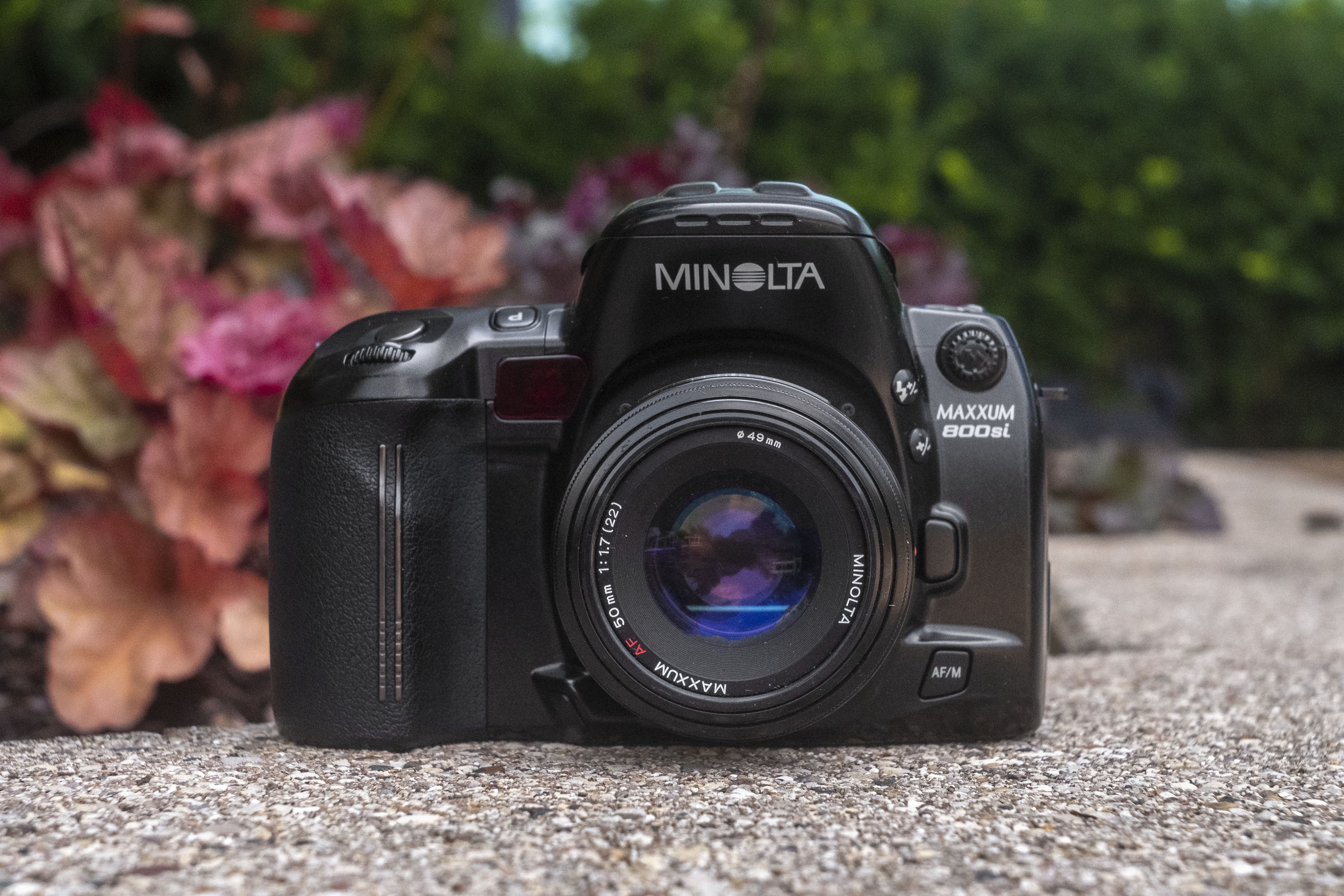

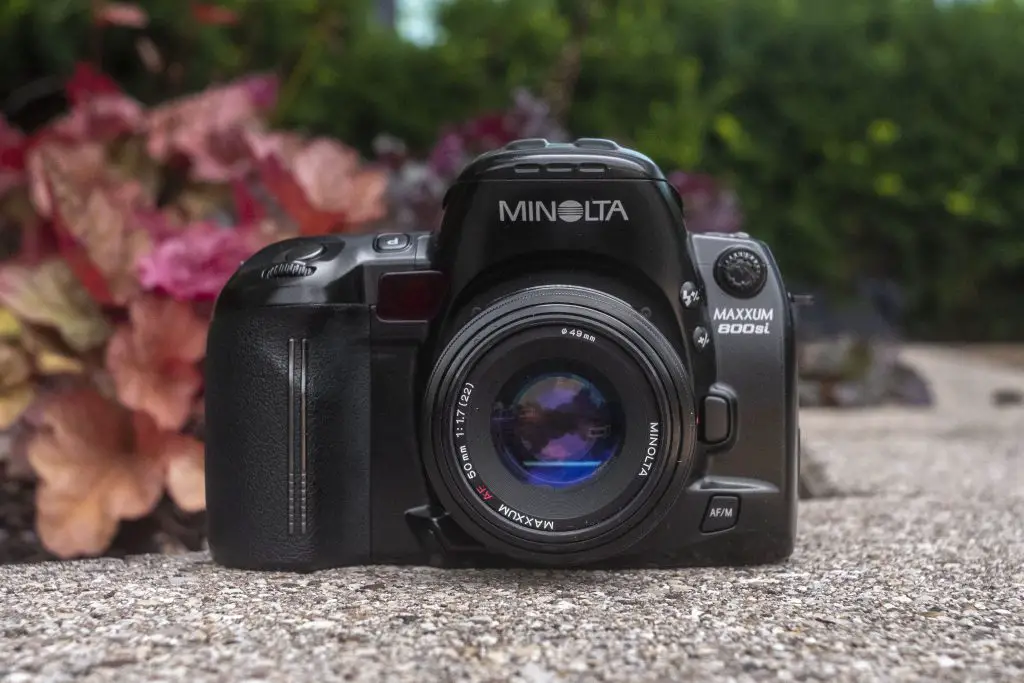

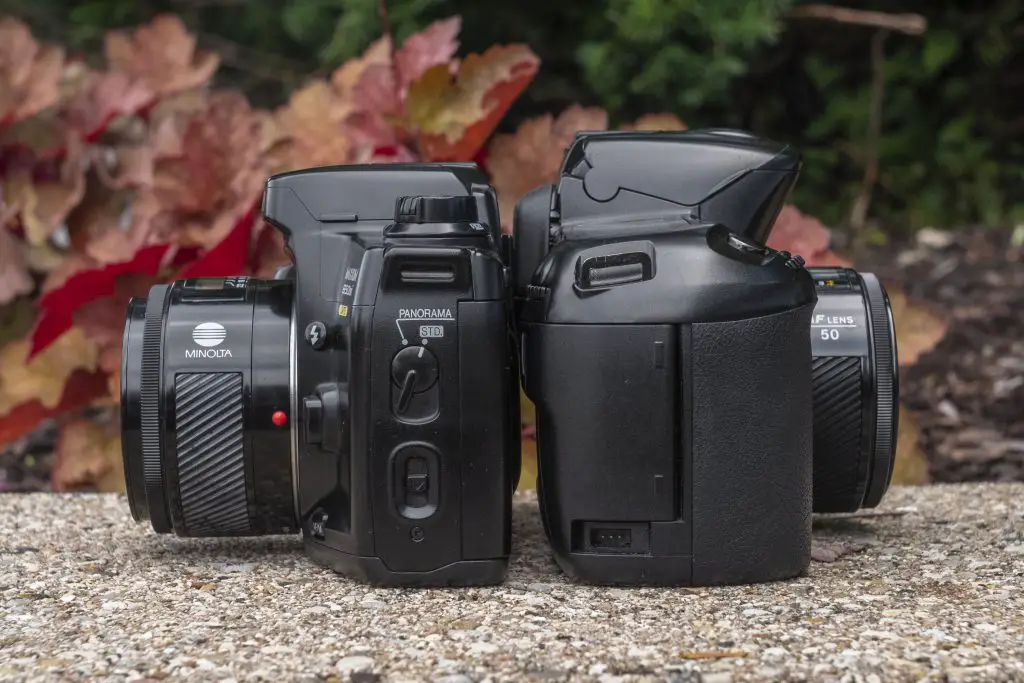
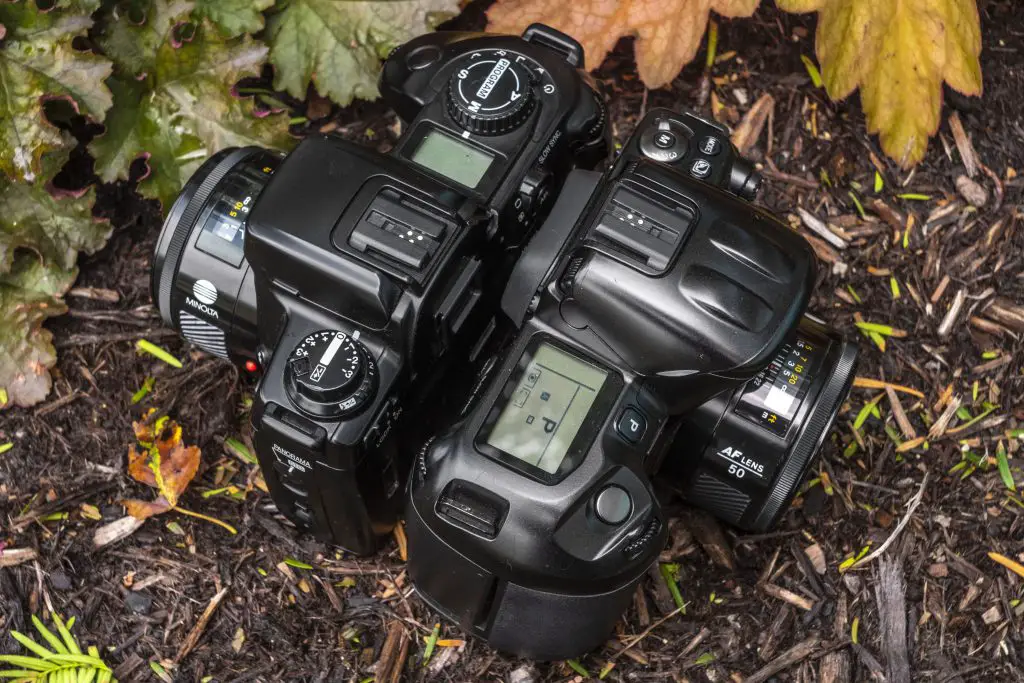
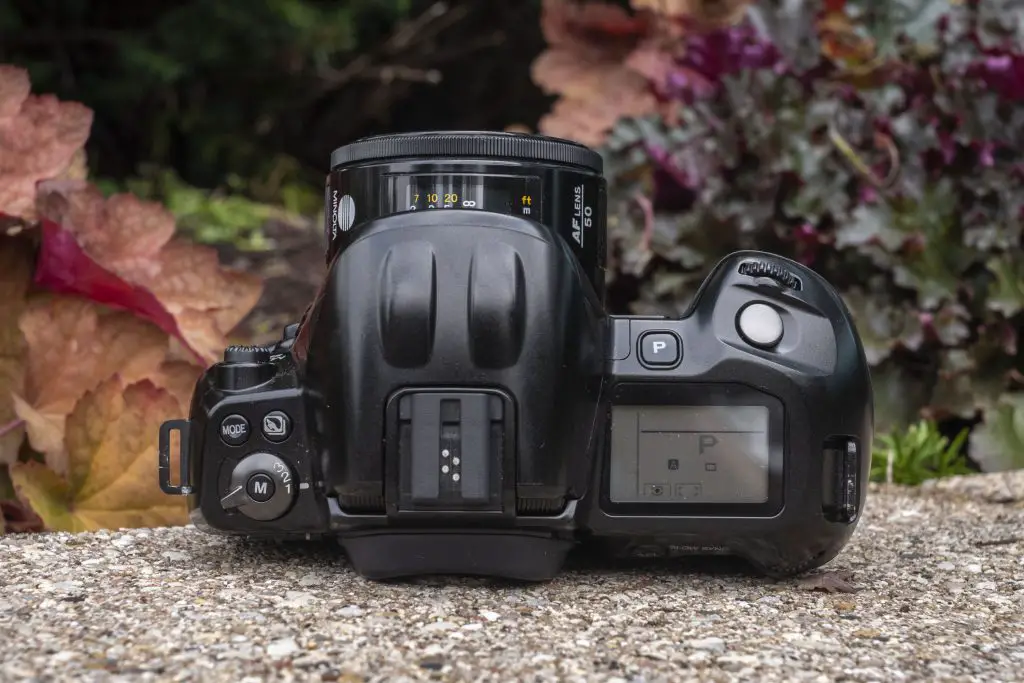
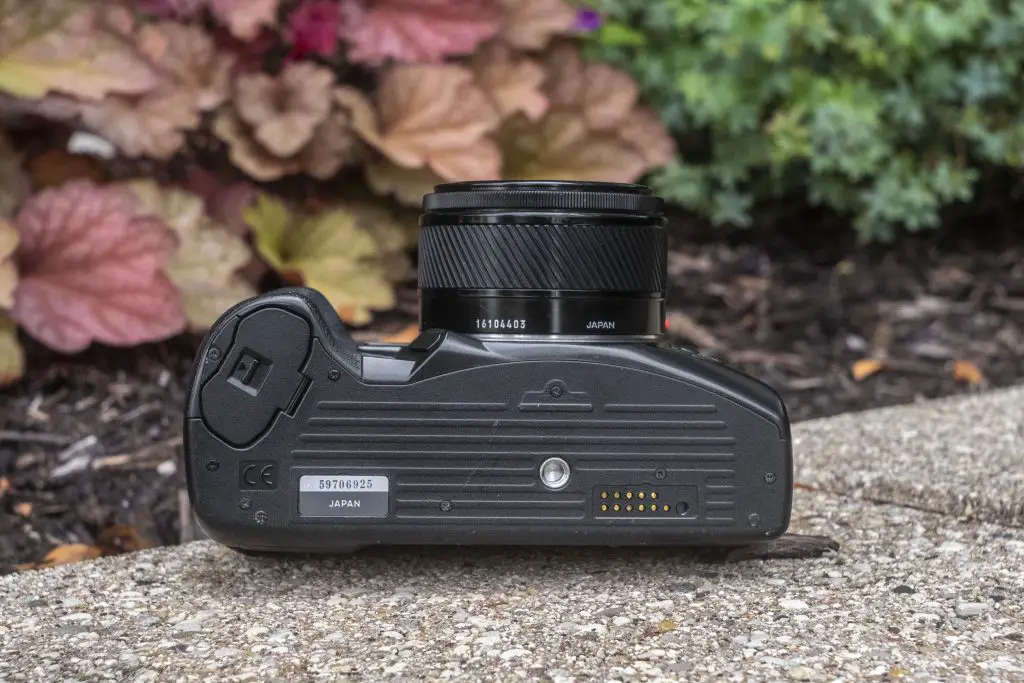
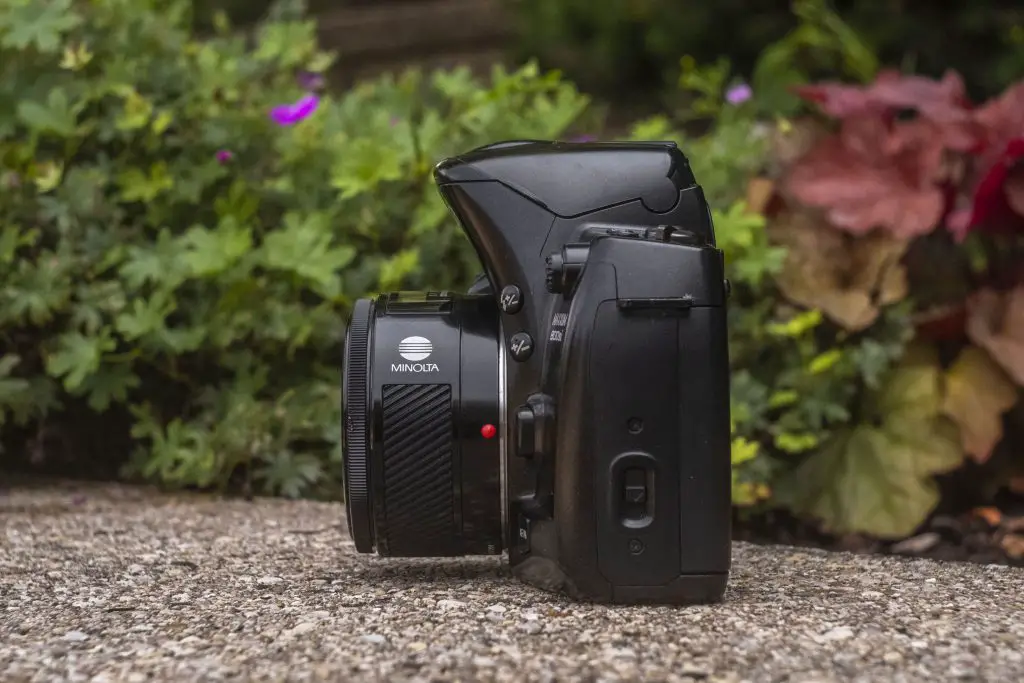
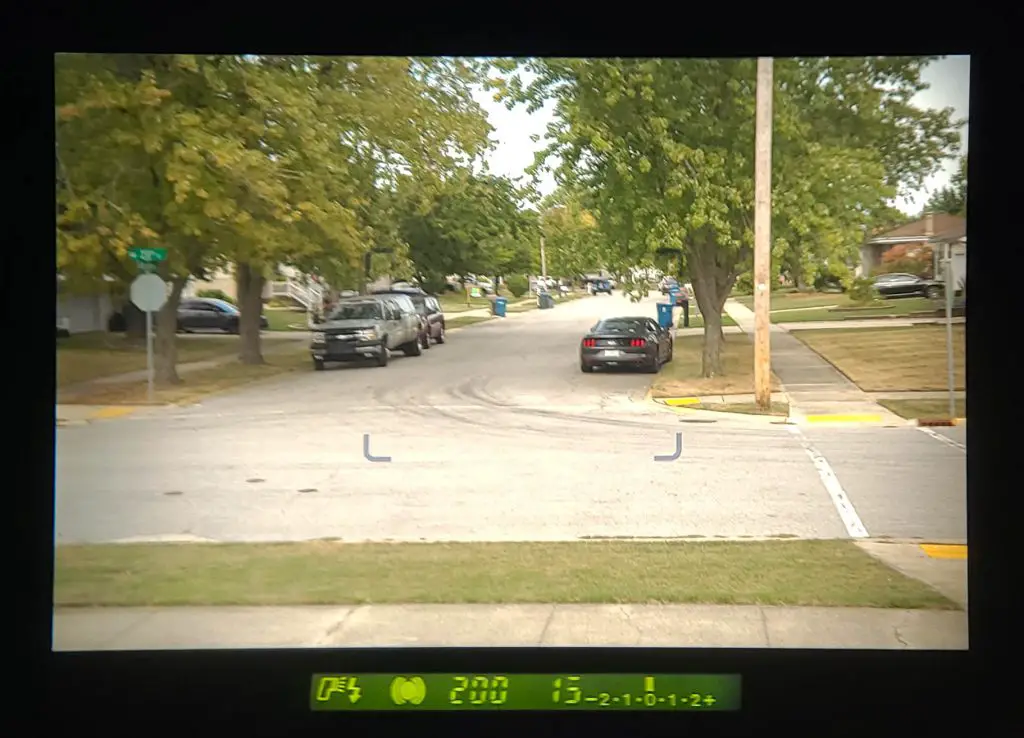
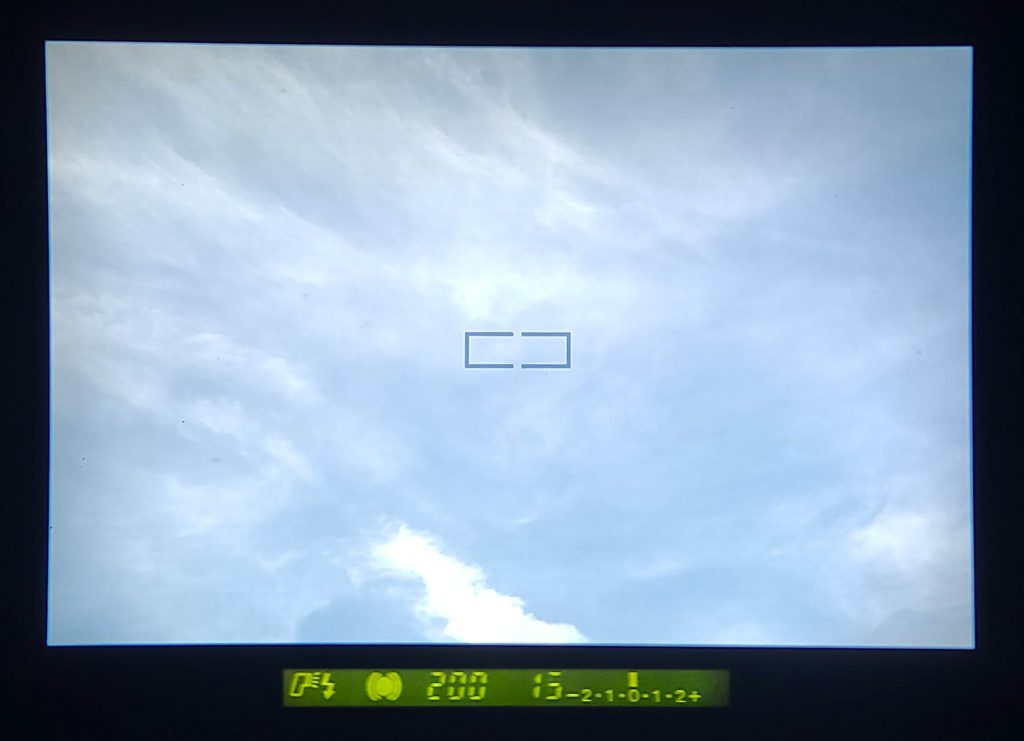
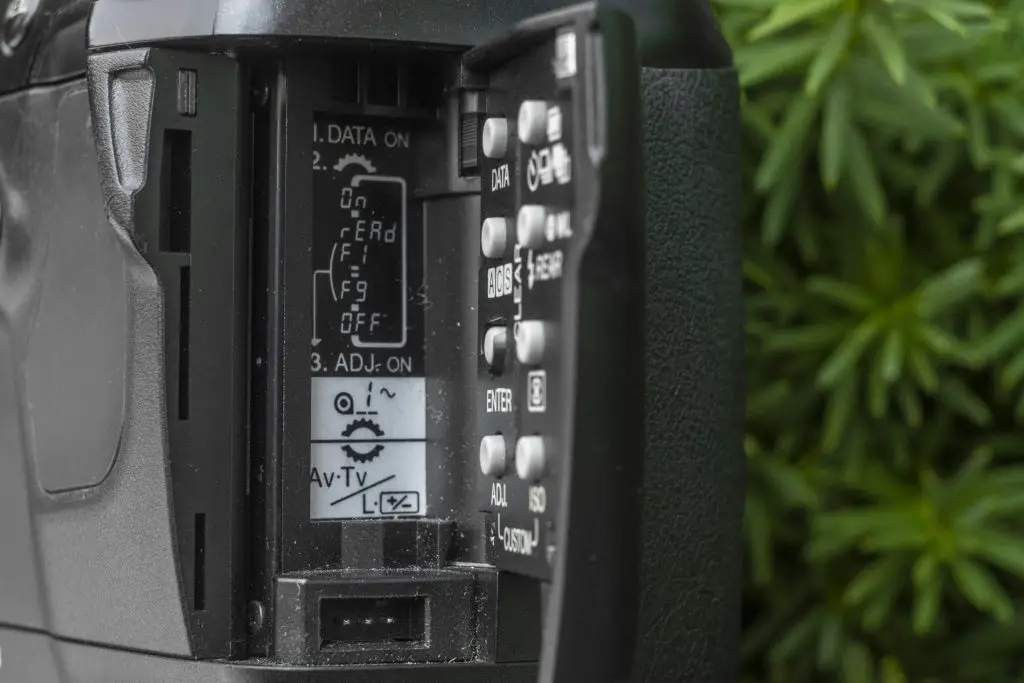
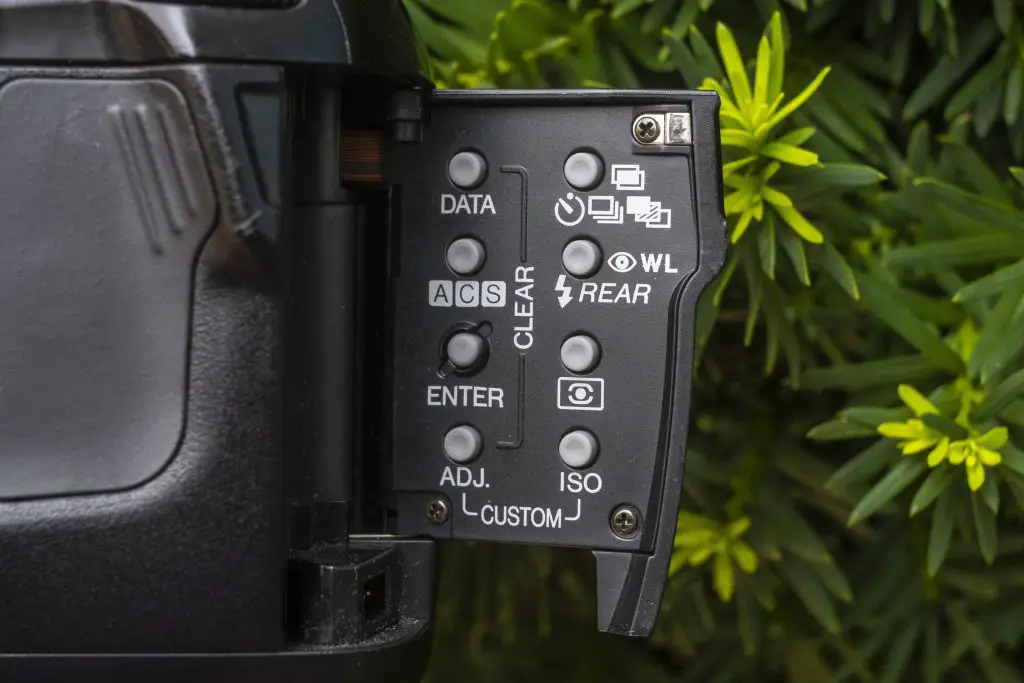


















The “Program Reset” button first appeared on the Maxxum 7000i and could be found on all of the top models. Also while sales of the later Maxxum models was poor in the USA, they seem to do well in the Far East. Many of the the fourth and fifth generation cameras on Ebay seem to come form Japan. Finally, my favorite Maxxum is the Alpha 7 which I regard as the best SLR film camera ever made, including the Nikon F6.
I do have a couple Alpha 7s as those seem to be highly revered cameras by many collectors and shooters, and while I love the large rear LCD and the overall ergonomics of them, I am 0 for 3 in getting ones that work correctly. It seems Minolta cheapened out on some aperture control pieces in the lens mount which become brittle and crack. Every single one I’ve come across has had an issue where either the shutter wouldn’t fire at all, or if it did, it would return an error at anything than the lens being wide open. I know it’s not fair to assess a whole model on a couple broken examples, but I just find it hard to recommend a camera that has such an obvious fault, no matter how good the rest of it is.
Minolta was my camera of choice way back around 1972 when I purchased the SRT-102. I stayed with Minolta up until they transitioned to SONY, then I went SONY because they kept the Minolta mount. Today, I’m still SONY but for more reasons than originally. I never owned a Maxxum because I was happy with my older SRT and XE7. Besides, I became a curmudgeon type photographer that prefers manual focus and total control of my photography. The Maxxum is a great example of Minolta’s ingenuity and industry leading advancements. I was and still am very disappointed to have seen them exit the photo business. I now use digital but am still old-fashioned in the way I approach photography. I’ve always considered the camera to be a box that contained a shutter, more or less fancy. However, today, I do appreciate some of what is offered by digital cameras, although only a relatively small amount of it.
Minolta definitely was an innovative company. I talk about their many accomplishments in my review for the Minolta Talker. Even from their very first cameras in the 1930s, they weren’t content to just copy others, they always tried to make something special, which for most of the 20th century, they were successful at!
Mike, Thanks for this post, which is, yes, a departure from your unusual and odd. Minolta was underrated, but somehow represents great Japanese creative engineering. I actually have a 650 but haven’t tried putting film through it. Instead, I’m trying to determine which best lens(es) to use with it before I do. Since you have seemed to use this a fair amount, which lenses work well for you? Any zooms? The Minolta line seems to have hits and misses…
-Bob G.
I have a variety of AF Minolta primes, but the one I use the most is the 28mm f/2.8. My “mind’s eye” sees in wide angle better than others, so I tend to have that lens mounted the most often. I do have a Minolta AF 70-210 though which I have used and it is optically excellent, although the AF performance is a bit sluggish. I shot prairie dogs at Teddy Roosevelt National Park and on a number of occasions it had to hunt, but when it did get it right, the images were great!
Definitely put some film through that 650 as it’s a wonderful camera to use. As is the 800 too, but they’re harder to find.
Hi Mike, great to see you featuring this camera. I’ve just got one of these in the mail and sadly mine seems to be an outlier as my grip showed visible cracking and was starting to flake off. Would likely try to look for a replacement sometime. On the plus side, it came with the add-on VC700 grip which makes its handling even better. Looking forward to giving it a spin sometime soon
That is unfortunate to hear! I had hoped that the different material than what was used on the 650si meant it would hold up better! Still, both cameras are excellent shooters!
Great review, thanks. I have used quite a few Minoltas over the years (Xd7, SR-T 102 and 100, 7000, 9000, 7000i, 8000i, 9xi, 7xi, 5xi, X-700 and 700si) and have kept two SrT and the 700si.
Unfortunately, the AF cameras are crippled by the aperture mechanism malady. My 7000, 9000, 8000i and 7xi were affected by it. The 700si played up once but hasn’t done it since. I see reports of the latest Dynax 7 being affected too – why Minolta never addressed it is beyond me (they knew it since the 9000 was discontinued). Great cameras but with an expiring date. I am frequently tempted to get a 800si but I quickly snap back to my logical brain.
Great review I thought , you reinforced some same thoughts as I have with my 800si which is two years old now !
In 1990 the 8000i started the adventure of Minolta Maxxum for me !
In 1997 I bought the 9Xi and love that body and what it will do with ease !
In 1999 I found a 9000 used like new in the box so I brought it home , just loved that camera body !
I’m thinking about adding the Maxxum 7 now to my line up !
Those later Maxxums were all great! I recently shot my 800si again recently and it still worked great! I don’t know if it’s bad luck however, but I am 0 for 3 on Maxxum 7s though. I even have a Japanese marked alpha 7 and they all have the aperture stop down error which renders the camera unable to stop down the lens. I would caution you on spending too much on one unless you know for sure it works!
Not mentioned, is that while there was (as best I can tell) no Maxxum 850si offered in the US market, the Japanese a-807si has the panoramic mode switch on the left side. What’s neat is that the finder doesn’t have slats that crop out the viewfinder – it uses lines of dashes in viewfinder display, much like the focus points. I bought mine direct from Japan, and it included the power grip, which allows use of 4 AA batteries instead of the harder to find 2CR5. Gives the camera a nice balance as well.